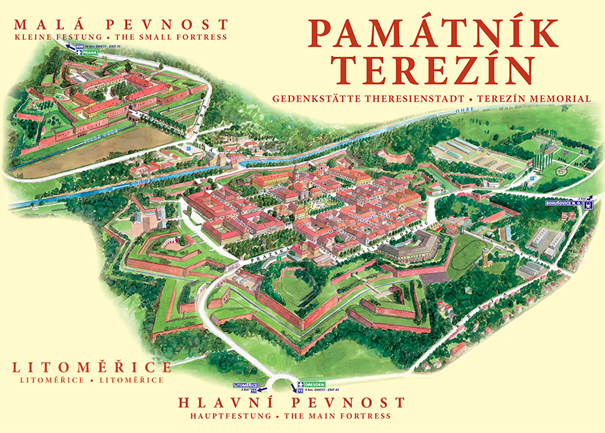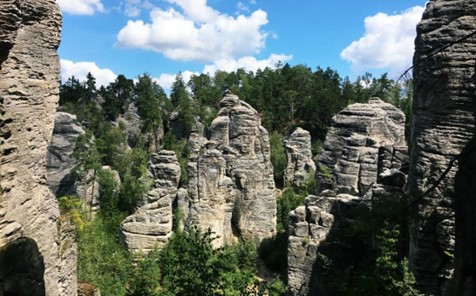One Day Trips Out of Prague
One Day Trips Out of Prague
Explore the beautiful attractions around Prague with our comprehensive guide. From historic castles to stunning natural formations, there's something for everyone to enjoy. Use the links below to quickly navigate to different sections of the page.
Historical Monuments and Castles
Karlštejn Castle
The Karlštejn Castle is one of the most famous Czech Gothic medieval castles situated in the middle of the protected landscape area of the Bohemian Karst. It was founded around 1348 by Czech King Charles IV as his private residence. After Charles's coronation as Roman Emperor, Karlštejn became a treasury where the crown jewels and relics of saints were kept.
Among the most valuable preserved areas of the castle are the Chapel of St. Catherine, the Church of the Assumption of the Virgin Mary, and the Chapel of the Holy Cross. In the Chapel of the Holy Cross, there is a set of 129 Gothic panel paintings which are unparalleled in the world.
Website: Visit the Karlštejn Castle website
Opening Hours: Tuesday–Sunday 09:30–17:30

Source: https://putovanisvetem.cz/karlstejn-tajemny-hrad-plny-historie-a-krasy/
Konopiště Château
The last private owner of Konopiště Chateau was František Ferdinand d'Este who moved his extensive collections there and established the Rose Garden using greenhouses. At the castle it is possible to take part in four visitor tours. These tours are offered in English, German, Russian, or French.
Website: Visit the Konopiště Château website
Opening Hours: September, Tuesday–Sunday 10:00–16:00
Accessibility: A stair climber enables the visit of the 1st tour (Apartments of the south wing of the castle) for disabled people in a wheelchair. Please note that for technical reasons a maximum of two trolleys can be taken on one tour (batteries must be recharged) and prior booking is required.

Source: https://www.zamek-konopiste.cz/
Dobříš Château
This Renaissance castle houses an exhibition of mixed rooms furnished with 17th and 18th century furniture focusing on the aristocratic Collored and Mansfeld families who owned it. The timeline of the exhibition begins in the year 962, the year the Holy Roman Empire was founded. The exhibition continues through 1771 when the Colloredes and Mansfelds were united by marriage (Colloredo-Mansfelds) through the Industrial Revolution to the end of the 20th century.
In addition to the castle itself, you can also visit the Orangery, a reconstructed former castle greenhouse that now houses a number of exhibitions.
Nature lovers can stroll through the French and English Parks. The French park is made up of five terraces that total two hectares. Visitors can admire the rose garden, take a photo by the muskrat sculpture, or relax for a while by the large fountain. The English park, covering almost 30 hectares, is characterised by its sloping and heavily vegetated terrain. There are viewpoints and, in the spirit of Romantic architecture, three artificial caves.
Website: Visit the Dobříš Château website
Opening Hours in September: Wednesday–Sunday 09:00–17:00 (Closed on 14 September 2024)

Source: https://www.zamekdobris.cz/
Historical Towns and Cities
Český Krumlov
The medieval centre of the town has been an urban conservation area since 1963 and a UNESCO World Heritage Site since 1992. Český Krumlov State Castle and Château is the second largest castle and château complex (the first being Prague Castle) in the Czech Republic and is one of the most important monuments in Central Europe, combining several artistic styles. Originally a Gothic castle, it was rebuilt as a Renaissance castle in the 16th century and in the following centuries was subject to Baroque and Rococo modifications.
In addition to the castle and chateau, other places to visit in the city include the Monastery Museum, Port 1560 (former manor brewery now a museum), Graphite Mine, Moldavite Museum, Wax Museum, Museum of Torture, Museum of Historical Motorcycles, and more.
Website: Visit the Český Krumlov website


Sources: https://www.ckrumlov.info/
Pilsen (Plzeň)
Pilsen is probably best known abroad as a brewery town but Pilsner beer is not the only thing the city has to offer visitors. The dominant feature of the city is the gothic Cathedral of St. Bartholomew which is a national cultural monument. Other important religious monuments include the Franciscan Monastery with the Church of the Assumption of the Virgin Mary, and the Baroque Dominican Monastery which now houses the Pilsen Region Study and Research Library.
Visitors should not miss the Great Synagogue, the second largest synagogue in Europe. The Old Synagogue and the New Jewish Cemetery include a memorial to the victims of the Holocaust. Other important sights of the city include the Renaissance Pilsen Town Hall, the Marian Column, and the residential interiors of architect Adolf Loos. Pilsen is also home to the Zoological and Botanical Garden.
Website: Visit the Pilsen website

Source: https://bohemia-balon.cz/en/kde-letame/plzen
České Budějovice
České Budějovice is located at the confluence of the Vltava and Malše rivers. The historic centre is an urban conservation area. The most important sights of the town include Přemysl Otakar II Square with the Baroque Samson Fountain and the Town Hall, the Baroque Cathedral of St. Nicholas with the adjacent Black Tower, and Chapel of the Deathly Sorrows of the Lord or Piarist Square.
Website: Visit the České Budějovice website

Source: https://www.visitceskebudejovice.cz/
Kutná Hora
The centre of the town is a historical preserve and together with the Saint Barbara's Church, the Church of the Assumption of Our Lady and Saint John the Baptist, it is included in the UNESCO World Heritage List. Visitors to Kutná Hora should also not miss a visit to the Sedlec Ossuary which is sure to leave an indelible impression with its impressive interior decorated with the bones of the deceased.
Other sights associated with the town's historical silver mining and coinage include the Italian Court and the Czech Museum of Silver.
Website: Visit the Kutná Hora website

The Saint Barbara's Church
Source: wikipedia

Sedlec Ossuary
Source: https://www.kampocesku.cz/
Memorials
Terezín Memorial
Over 140,000 Jewish prisoners, including women and children, passed through the Terezín ghetto during World War II. 35,000 prisoners died there over its course. Today Terezín is a national cultural monument and a memorial to the atrocities committed by the Nazi regime during the occupation of Czechoslovakia.
Visitors can see the Small Fortress (including National cemetery) and the buildings of the former ghetto, including Ghetto Museum, Magdeburg Barracks, Prayer room and replica of "mansard", Exhibition Ceremonial halls, columbarium, a central mortuary, Crematorium, Jewish cemetery, and the Cemetery of Soviet and Russian soldiers. In all these buildings, there are extensive permanent exhibitions thematically focused on life and death in the former ghetto and concentration camp.
Website: Visit the Terezín Memorial website
Opening Hours in September: Daily 09:00–17:00
Here is a guide how to get there
Accessibility: Wheelchair accessible except for the sightseeing route in the Little Fort, which is accessible with light assistance.

Source: https://www.pamatnik-terezin.cz/
Brewery Tours
Únětice Brewery
The Únětice brewery was probably founded in 1710. During World War II, the brewery's activity was stopped. The subsequent resumption of activity did not last long as the brewery was closed again in 1951 and waited another 60 years for its reopening. Regular tours of the brewery take place every Saturday and Sunday from 12 noon. They always start at the brewery's tap room and are free of charge.
Website: Visit the Únětice Brewery website

Source: wikipedia
Nature Attractions
Prachov Rocks
The Prachov Rocks are a sandstone rock area forming a unique sandstone rock "town". The rocks are a nature reserve and part of the Protected Landscape Area in Bohemian Paradise. As a result, there is an exceptional natural ecosystem here in which endangered animal and plant species can be found. There is a fee for parking and entrance.
Visitors can choose from up to four hiking circuits (one is specially adapted for strollers). There are a number of modified viewpoints among the rocks and there is a natural pond called Pelíšek. Climbers who are members of the CHA or UIAA can buy a special ticket and climb the selected rocks.
Website: Visit the Prachov Rocks website
Opening Hours: September, 08:00–18:00

Source: https://turistickamapa.cz/
Koněprus Caves
The Koněprus Caves are located in the Bohemian Karst Protected Landscape Area near the Karlštejn Castle. It is the longest cave system in Bohemia consisting of a three-storey system with a height difference of up to 70 metres between each floor. Visitors can enter the smallest (highest) and the largest (middle) floor. The lowest floor is inaccessible. Numerous paleontological finds have been discovered in the caves. Tours are guided.
Website: Visit the Koněprus Caves website
Opening Hours in September: Daily 09:00–16:00

Source: https://konepruske.caves.cz/
Quarries
The Velká Amerika quarry, sometimes called the Czech Grand Canyon, is a limestone quarry about 800 m long, 200 m wide, and up to 100 m deep, flooded with clear water. Nearby is a slightly smaller flooded limestone quarry, Little America, connected to Big America by underground tunnels. The smallest quarry is the Mexico Quarry. All the quarries are off limits but there are viewing platforms for visitors and it's also possible to take a walk around the quarry and enjoy the impressive views of the azure blue water.
Nearby is the state castle Karlštejn
Website: Visit the Quarries website

Source: https://www.berounsko.net/
